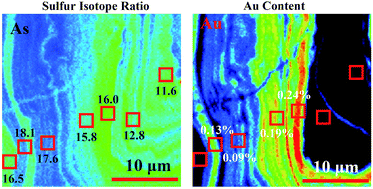当前位置:
X-MOL 学术
›
Anal. Methods
›
论文详情
Our official English website, www.x-mol.net, welcomes your
feedback! (Note: you will need to create a separate account there.)
Simultaneous determination of sulfur isotopes and trace elements in pyrite with a NanoSIMS 50L
Analytical Methods ( IF 2.7 ) Pub Date : 2017-10-30 00:00:00 , DOI: 10.1039/c7ay01440f Jianchao Zhang 1, 2, 3, 4, 5 , Yangting Lin 1, 2, 3, 4, 5 , Jun Yan 3, 5, 6, 7, 8 , Jinxiang Li 3, 5, 6, 7, 8 , Wei Yang 1, 2, 3, 4, 5
Analytical Methods ( IF 2.7 ) Pub Date : 2017-10-30 00:00:00 , DOI: 10.1039/c7ay01440f Jianchao Zhang 1, 2, 3, 4, 5 , Yangting Lin 1, 2, 3, 4, 5 , Jun Yan 3, 5, 6, 7, 8 , Jinxiang Li 3, 5, 6, 7, 8 , Wei Yang 1, 2, 3, 4, 5
Affiliation

|
Pyrite is common sulfide mineral involved in the formation of various ores and hydrothermal and biogenetic activities, and its S isotopic ratios and trace element contents and their spatial distribution have been recorded in the processes of these events. We established simultaneous analyses of 34S/32S ratios and trace element contents of pyrite using nanometer-scale secondary ion mass spectrometry (NanoSIMS). Firstly, the images of S (34S−), As (75As−), Se (80Se−), Cu (63Cu32S−), Au (197Au−) and Pb (208Pb32S−) of pyrite were acquired by rastering areas ranging from 20 × 20 μm2 to 40 × 40 μm2 using a Cs+ beam of 7–10 pA with a diameter of ∼250 nm. Then, the 34S/32S ratios (32S− measured by using a Faraday cup and 34S− measured by using an electron multiplier) and the concentrations of these trace elements of the individual layers of the zoned pyrite grains were simultaneously measured in spot analysis mode, by rastering the same current over an area of 2 × 2 μm2. The 34S/32S ratios were calibrated for matrix effects with pyrite standard Balmat or Py1117, and the external reproducibility (1SD) is <0.5‰. The concentrations of trace elements were calibrated using the relative sensitivity factors (RSFs) of As, Se, Cu, Au and Pb, which were determined from pyrite grains with zoning layers. The determined RSFs of As, CuS, Au and PbS are 4.43 ± 0.28, 0.36 ± 0.04, 0.18 ± 0.03 and 38.0 ± 15.1, respectively. Pyrite from Lannigou Carlin type gold deposits was analyzed as an example, and the results revealed three main episodes of its formation, with each superposed by micron-width oscillation zonings of trace elements. This method has important potential applications in isotopic and elemental investigation of thin layers of pyrite and other sulfides.
中文翻译:

用NanoSIMS 50L同时测定黄铁矿中的硫同位素和微量元素
黄铁矿是一种常见的硫化物矿物,参与各种矿石的形成以及热液和生物成因活动,在这些事件的过程中已记录了其硫同位素比,微量元素含量及其空间分布。我们使用纳米级二次离子质谱(NanoSIMS)建立了同时分析34 S / 32 S比值和黄铁矿中微量元素含量的分析方法。首先,S(的图像34小号- ),如(75个作为- ),硒(80硒- ),铜(63铜32小号- ),金(197金- )和Pb(208铅32小号- )黄铁矿的被光栅区域范围从20×20微米获取2至40×40微米2使用CS + 7-10帕光束的直径为〜250纳米。然后,将34 S / 32 S比率( 32小号-通过使用法拉第杯和测得的34小号-通过使用电子倍增器测量的)和划黄铁矿颗粒的各个层的这些微量元素的浓度同时在测量斑点分析模式中,由光栅相同的电流,在2×2μm的区域2。的34 S / 32使用黄铁矿标准Balmat或Py1117校准了基质的S比值,并且外部重现性(1SD)<0.5‰。痕量元素的浓度使用As,Se,Cu,Au和Pb的相对灵敏度因子(RSF)进行校准,这些相对灵敏度因子是从具有分区层的黄铁矿晶粒中确定的。确定的As,CuS,Au和PbS的RSF分别为4.43±0.28、0.36±0.04、0.18±0.03和38.0±15.1。以Lannigou Carlin型金矿的硫铁矿为例进行了分析,结果揭示了其形成的三个主要事件,每个事件都与微量元素的微米宽度振荡区带叠加。该方法在黄铁矿和其他硫化物薄层的同位素和元素研究中具有重要的潜在应用。
更新日期:2017-11-22
中文翻译:

用NanoSIMS 50L同时测定黄铁矿中的硫同位素和微量元素
黄铁矿是一种常见的硫化物矿物,参与各种矿石的形成以及热液和生物成因活动,在这些事件的过程中已记录了其硫同位素比,微量元素含量及其空间分布。我们使用纳米级二次离子质谱(NanoSIMS)建立了同时分析34 S / 32 S比值和黄铁矿中微量元素含量的分析方法。首先,S(的图像34小号- ),如(75个作为- ),硒(80硒- ),铜(63铜32小号- ),金(197金- )和Pb(208铅32小号- )黄铁矿的被光栅区域范围从20×20微米获取2至40×40微米2使用CS + 7-10帕光束的直径为〜250纳米。然后,将34 S / 32 S比率( 32小号-通过使用法拉第杯和测得的34小号-通过使用电子倍增器测量的)和划黄铁矿颗粒的各个层的这些微量元素的浓度同时在测量斑点分析模式中,由光栅相同的电流,在2×2μm的区域2。的34 S / 32使用黄铁矿标准Balmat或Py1117校准了基质的S比值,并且外部重现性(1SD)<0.5‰。痕量元素的浓度使用As,Se,Cu,Au和Pb的相对灵敏度因子(RSF)进行校准,这些相对灵敏度因子是从具有分区层的黄铁矿晶粒中确定的。确定的As,CuS,Au和PbS的RSF分别为4.43±0.28、0.36±0.04、0.18±0.03和38.0±15.1。以Lannigou Carlin型金矿的硫铁矿为例进行了分析,结果揭示了其形成的三个主要事件,每个事件都与微量元素的微米宽度振荡区带叠加。该方法在黄铁矿和其他硫化物薄层的同位素和元素研究中具有重要的潜在应用。











































 京公网安备 11010802027423号
京公网安备 11010802027423号